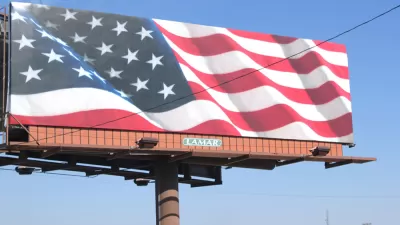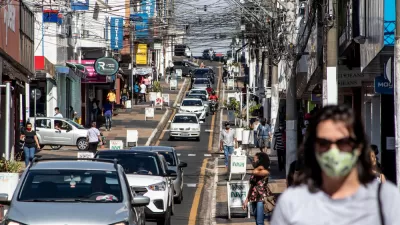Cities around the world have continued to implement drastic measures in reaction to a proliferation of billboards.
Arwah Mahdawi examines the spreading influence of the city of São Paulo's 2007 Clean City Law:
"In the last decade, from Bristol to Tehran, there been a global movement to un-brand cities – to rid them, at least partially, of adverts. Citizen vigilantes, artists and activists are playing important roles. Etienne Lavie, for example, has re-imagined what cities would look like if classical paintings replaced adverts; a team of developers in New York has created No Ad, an augmented-reality app that strips the New York City subway of ads, replacing them with art; and in 2008 a group of Bristol citizens petitioned (albeit unsuccessfully) to ban advertising from the city."
The work of those citizen vigilantes, according to Mahdawi, has also produced policy change from municipalities:
"In 2009, Chennai, India banned the erection of billboards, and several US states including Vermont, Maine, Hawaii, and Alaska are billboard-free. In 2011, Paris set out plans to reduce the number of ad hoardings by a third. And earlier this year, Tehran replaced all its 1,500 advertising billboards with art for 10 days."
The article goes on to examine a few surprising arguments for keeping billboards, the case made by the aforementioned vigilantes, and the consequences of the decision to remove 15,000 billboards and 300,000 over-sized storefront signs from São Paulo.
FULL STORY: Can cities kick ads? Inside the global movement to ban urban billboards

Alabama: Trump Terminates Settlements for Black Communities Harmed By Raw Sewage
Trump deemed the landmark civil rights agreement “illegal DEI and environmental justice policy.”

Planetizen Federal Action Tracker
A weekly monitor of how Trump’s orders and actions are impacting planners and planning in America.

How Atlanta Built 7,000 Housing Units in 3 Years
The city’s comprehensive, neighborhood-focused housing strategy focuses on identifying properties and land that can be repurposed for housing and encouraging development in underserved neighborhoods.

In Both Crashes and Crime, Public Transportation is Far Safer than Driving
Contrary to popular assumptions, public transportation has far lower crash and crime rates than automobile travel. For safer communities, improve and encourage transit travel.

Report: Zoning Reforms Should Complement Nashville’s Ambitious Transit Plan
Without reform, restrictive zoning codes will limit the impact of the city’s planned transit expansion and could exclude some of the residents who depend on transit the most.

Judge Orders Release of Frozen IRA, IIJA Funding
The decision is a victory for environmental groups who charged that freezing funds for critical infrastructure and disaster response programs caused “real and irreparable harm” to communities.
Urban Design for Planners 1: Software Tools
This six-course series explores essential urban design concepts using open source software and equips planners with the tools they need to participate fully in the urban design process.
Planning for Universal Design
Learn the tools for implementing Universal Design in planning regulations.
Caltrans
Smith Gee Studio
Institute for Housing and Urban Development Studies (IHS)
City of Grandview
Harvard GSD Executive Education
Toledo-Lucas County Plan Commissions
Salt Lake City
NYU Wagner Graduate School of Public Service




























